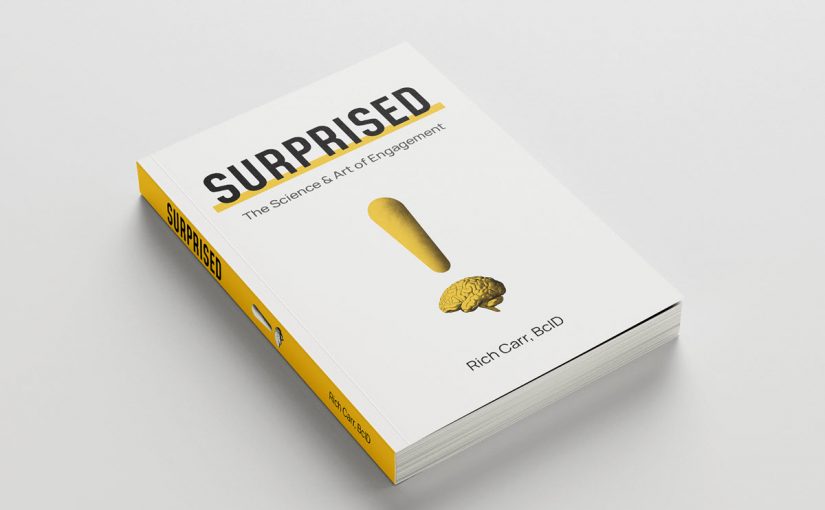
Engagement in communication begins with capturing attention, and that’s where the element of Surprise plays a crucial role. Think of it as a sequence: Surprise, Attention, Engagement. While Surprise acts as a powerful initiator, it’s only a piece of the larger puzzle.
To sustain engagement, Surprise needs to be incorporated into elements like curiosity, relevance, Challenge, and relatability to become essential. Factors like beauty, humor, emotion, and social interaction amplify this engagement, especially when strategically placed for effect.
Greenhousing: A brain-centric approach to learning and development that provides a nurturing, controlled environment optimized for engagement and understanding. Greenhousing fosters improved performance, innovation, and adaptability by providing an environment conducive to inclusive and continuous learning.
Rich Carr, BcID
This understanding forms the cornerstone of Brain-centric Design. This approach aligns perfectly with the brain’s natural processing mechanisms. Within its framework, notably the Challenge Wheel, strategic placement of surprises ensures the audience remains engaged. The Challenge Wheel isn’t just a method; it’s an experience. From the moment it’s introduced, the audience feels a direct connection, as if the content is tailored specifically for them, addressing their immediate needs and concerns.
In this whole-brain, learner-centric approach, incentives aren’t materialistic. The real rewards are intangible yet deeply fulfilling: autonomy, mastery, and purpose. The framework’s Multiple Perspectives section ensures varied insights, often from experts, shedding light on the presented Challenge. Here, the Challenge Wheel brilliantly integrates Hebb’s Rule into the mix.
Hebb’s Rule, often summarized by the phrase “neurons that fire together wire together,” is one of the foundational concepts in neuroscience and psychology. Donald Hebb proposed it in his 1949 book “The Organization of Behavior.” The Rule describes a fundamental mechanism for synaptic plasticity, where an increase in synaptic efficacy arises from the repeated and persistent stimulation of one neuron by another.
To say that a bit clearer, describing Hebb’s Rule is like when you hang out with a friend and become best friends. The more you do things together, the closer you become.
In neuroscience, psychology, and cognitive science, Hebb’s Rule is highly regarded and fundamental to understanding learning and memory. The concept has influenced theories about neural network learning in artificial intelligence and has been foundational in developing various neural network algorithms.
While it might not be a household name for the general public, anyone who has studied cognitive science, psychology, or related fields is likely familiar with Hebb’s Rule due to its significance in explaining how neural connections strengthen through repeated activation.
Imagine your brain is like a big neighborhood with many houses (these are our neurons). When you learn something new, it’s like making a path between two houses.
At first, the path might be hard to see and easy to forget. But the more you walk on it, the clearer and more permanent it becomes. It’s like when you and your friend walk to each other’s houses all the time; you know the path by heart.
Hebb’s Rule is like saying, “The more you walk on the path, the easier it is to remember and use.” It’s a way scientists talk about how we learn and remember things. It’s like practicing; the more you do something, the better you get at it!
If we take your ‘brain’s neighborhood’ and divide it into four main sections, like four big parks, each park helps you learn differently. These parks represent the four learning lobes of the brain.
Frontal Park (Frontal Lobe):
What it does: This is where you make decisions and figure out how to solve problems.
Perspective: Imagine you’re trying to plan a group workshop to develop your unit’s future vision. Someone might suggest, “Let’s use the Challenge Wheel to help us set up our collaboration on the same page!” This perspective helps you think about organizing and deciding.
Parietal Playground (Parietal Lobe):
What it does: This part helps you understand where things are and how they relate. It’s like understanding the rules of a game.
Perspective: Picture someone showing you a map of the competitive landscape and where each option is played out. This perspective helps you see the big picture.
Temporal Treehouse (Temporal Lobe):
What it does: This is where you remember the lyrics to songs or stories your parents told you.
Perspective: Imagine someone singing a catchy song related to the Challenge Wheel and how it works. This perspective uses sound and memory to help you remember.
Occipital Oasis (Occipital Lobe):
What it does: This part helps you see and understand pictures, colors, and anything visual.
Perspective: Think of someone showing you a colorful poster with pictures of how the Challenge Wheel can be used. This perspective uses images you must interpret to explain things.
When you learn something new, all these parts of the brain can work together. Different people might show you different ways (or perspectives) to understand the same thing. Each method is like taking a different path in one of the parks. The more you visit these paths, the clearer they become.
Another of the Challenge Wheel’s most vital attributes is its emphasis on relatability. The presented Challenge is always positioned in a way that is relevant and beneficial to the learner immediately and in the long run. The process is designed to make learning enjoyable, with the Cognitive 3Rs at its core. These components facilitate reflection and foster a sense of progress in the learner. The embedded social interaction further enriches the experience, prompting individuals to explore and question.
What sets this approach apart is its alignment with brain processes and emphasis on autonomy. The iterative nature of the Challenge Wheel provides comforting predictability while being infinitely adaptable. The underlying foundation prioritizes psychological safety, making it a reliable tool for all learners, echoing the findings in Thomas Boyce’s research known as ‘The Dandelion & The Orchid.’
The “Dandelion” and the “Orchid” concepts stem from Boyce’s research into children’s responsiveness to environmental conditions. Dandelions are robust and can thrive in a wide variety of settings, much like individuals who adapt and flourish regardless of circumstances. Orchids, however, can wilt if conditions aren’t just right but can also blossom extraordinarily when in the right environment. As these children grow up, they can change a bit: Orchids might learn to handle things better, and Dandelions might sometimes feel overwhelmed. Personal growth, life experiences, and environmental shifts can influence how these traits manifest. Generally speaking, once an Orchid, always an Orchid, and once a Dandelion, always a Dandelion.
We designed the Challenge Wheel ‘for the Orchid,’ meaning we created an inclusive learning environment tailored to those who might be more sensitive or responsive to environmental stimuli. Here’s how this approach ensures a conducive learning atmosphere:
Stress Reduction: By catering to Orchids, the Challenge Wheel inherently addresses common anxiety triggers. The structured, predictable nature of the Challenge Wheel provides a clear roadmap of what’s to come, reducing uncertainty.
No Boredom: Surprise and novelty continuously stimulate the learner’s interest. When learners are engaged and can relate to the content, boredom is pushed to the sidelines.
Freedom from Entrapment: The framework gives learners agency and autonomy, fostering an environment where they don’t feel cornered or overwhelmed. They have the freedom to reflect, revise, and review at their own pace.
Safety and Assurance: The predictability of the Challenge Wheel framework, combined with its focus on the learner’s perspective, builds trust. Learners know they are in a space where their emotional and cognitive needs are prioritized.
Engagement Over Worry: With the Challenge Wheel’s emphasis on emotional connection (Affect before Effect), learners are more invested in the content, leaving little room for external worries to creep in.
Now, when everyone in the group, including Dandelions, is placed in such an optimized environment, the collective learning experience is elevated. Dandelions, although adaptable, also benefit from a rich, stimulating, and supportive environment. The entire group achieves deep understanding because the barriers to learning are minimized, and the enablers of engagement, comprehension, connection, and reflection are maximized. When the most sensitive among us are nurtured, everyone flourishes.
Dandelions, known for their resilience and adaptability, also benefit immensely.
Enhanced Learning Experience: Even if Dandelions can manage in less optimal settings, they still gain from a more prosperous, more stimulating environment. The nuances and depths of the Challenge Wheel can provide insights and perspectives that they might not encounter in a standard learning setting.
No ‘Coasting’: Due to their adaptability, Dandelions might coast through many traditional environments without being genuinely challenged. The Challenge Wheel ensures engagement and Challenge for all, pushing Dandelions to explore more profound understanding and connections.
Emotional Resonance: While Dandelions are resilient, they are not void of emotions or preferences. The emotional connection emphasized in the Challenge Wheel (Affect before Effect) resonates with everyone, Dandelions included. They, too, appreciate content that speaks to their emotions and experiences.
Peer Learning: In a Challenge Wheel environment where everyone is engaged and contributing, Dandelions can benefit from the insights and reflections of their Orchid peers, leading to a richer collaborative learning experience.
Encouragement of Depth: The design of the Challenge Wheel encourages learners to explore deeper, reflect more, and connect various pieces of information. When given this encouragement, Dandelions can explore depths of topics they might not have otherwise.
While the Challenge Wheel is designed for Orchids, its principles are universal in promoting deep understanding, engagement, and emotional resonance. Although resilient and adaptable, Dandelions still flourish more vibrantly in such a well-constructed environment we often call ‘Greenhousing.’
“Greenhousing” as a term for this learning structure is profoundly fitting. Just as a greenhouse provides a controlled, nurturing environment for plants to thrive, the Challenge Wheel’s design ensures a conducive, safe, and supportive environment for all learners. The emphasis on addressing the Autonomic Nervous System (ANS) ensures that the environment minimizes stress and optimizes engagement.
The benefits of “Greenhousing” in a Business Context are instantly appreciated.
Enhanced Employee Performance: When employees are in an optimal state of learning, they absorb and apply knowledge more effectively. This state translates into improved job performance, increased innovation, and better problem-solving skills.
Reduced Training Time: An environment that caters to both Orchids and Dandelions can accelerate the learning process. With everyone engaged and the barriers to understanding removed, businesses can reduce the time and resources spent on training.
Inclusivity and Diversity: By catering to Orchids, businesses inherently support an inclusive learning environment, a key component in promoting diversity and inclusion in the workplace, fostering a culture of respect and understanding.
Higher Employee Retention: Employees value workplaces that invest in their growth and well-being. A “greenhoused” learning environment can lead to higher job satisfaction and reduce turnover rates.
Collaboration and Teamwork: Collaboration thrives when everyone is on the same page, and all voices are valued. The shared experiences in the learning environment can break down silos and promote cross-team collaboration.
Innovation Boost: A safe and inclusive learning environment encourages employees to think outside the box, take risks, and share novel ideas, leading to breakthrough innovations that drive business growth.
Resilience in Change: Businesses constantly evolve, and adaptability is critical. An environment with trained employees to embrace and understand new concepts readily can weather changes more smoothly.
In essence, the “Greenhousing” approach in learning, rooted in the principles of the Challenge Wheel, doesn’t just benefit individual learners. It has a ripple effect, touching every facet of a business, driving growth and innovation, and fostering a culture of inclusivity and continuous learning.



